



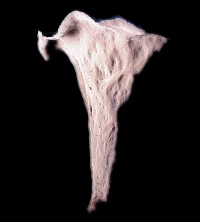


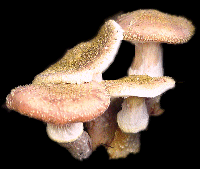














A peek inside Edible Wild Mushrooms of North America
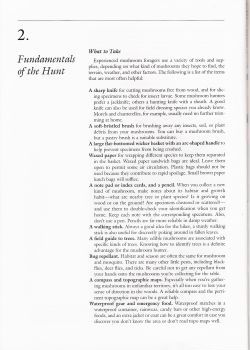
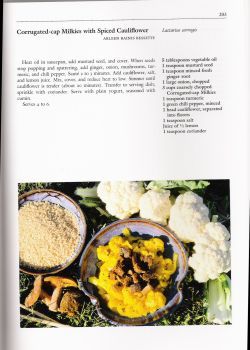
Pages 6, 203
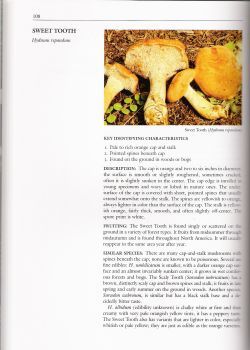
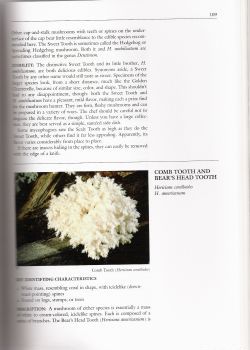
Pages 108, 109


Pages 135, 148
- Table of Contents
- List of Recipes
- Preface
- Sample Entry: Meadow Mushroom (Agaricus campestris)
- Sample Recipe
Table of Contents
- Preface
- Content
- Acknowledgments
- Part One. Discovering Mycophagy
- 1. An Introduction to the Mushroom
- 2. Fundamentals of the Hunt
- 3. What Have You Found?
- 4. The Mycophagist's Ten Commandments
- 5. How to Use this Guide and Beyond
- Part Two. Forgotten Fruit: Edible Wild Mushrooms of North America
- 6. Chanterelles And Similar Mushrooms
- 7. Gilled Mushrooms
- 8. Boletes
- 9. Tooth Mushrooms
- 10. Coral-Shaped, Club-Shaped, And Cauliflower-Shaped Mushrooms
- 11. Shelflike Mushrooms, Puffballs, Morels, And Jelly Fungi
- Part Three. Poisonous Wild Mushrooms of North America
- 12. Mushroom Poisoning
- 13. Poisonous Wild Mushrooms
- Part Four. Wild Mushrooms in the Kitchen
- 14. Preparing, Preserving, and Cooking Wild Mushrooms
- 15. Wild Mushroom Recipes
- Glossary
- Recommended Reading
- Index
List of Recipes
- Appetizers
- Black Trumpet Cracker Spread
- Arvensis Casino
- Matsutake Canapes
- Fried Two-colored Boletes
- Baked Stuffed Morels
- Marinated Wild Mushrooms
- Sausage-stuffed Mushroom Caps
- Stuffed Mushrooms
- Soups and Stews
- Meadow Mushroom Chicken Soup
- Hunters Stew
- Honey-cap and Lamb Stew
- Cream of Mushroom Soup
- Tortellini in Mushroom Broth
- Salads
- Black Trumpet Sweet and Sour Salad
- Lobster Mushroom Spinach Salad
- Shaggy Mane Salad
- Curried Cashew Chicken and Grayling Salad
- Cauliflower Mushroom Salad
- Hen of the Woods Salad
- Vegetables
- Wine-cap Stropharia with Madeira
- Kasha and Shaggy Parasols
- Snow Pea Pods and Fairy Ring Mushrooms
- Orange-latex Milkies with Milkweed Pods
- Corrugated-cap Milkies with Spiced Cauliflower
- Fawn Mushrooms au Gratin
- Hydnum Hash
- Creamed Morels and Potatoes
- Main Courses
- Meat
- Calabrese Mushroom Chili
- Pork with Purple Laccaria and Plum Sauce
- Cordon Blewit
- Oriental Oyster Mushrooms and Steak
- Late Fall Oyster Mushroom Pie
- Bolete and Sausage Pizza Roll
- Pheasant's Back Jambalaya
- Poultry
- Cornish Game Hens with Chanterelle Stuffing and Apricot Glaze
- Swiss Chicken Edulis
- Fish and Shellfish
- Black Trumpet Trout
- Salmon with Black Trumpets and Horseradish Sauce
- Laccaria Stir-fry
- Chroogomphus and Dungeness Crab Cakes
- Orange Roughy with Platterfuls
- Oyster Mushrooms Mornay
- Angel Wings and Scallop Crepes
- King Bolete Thermidor
- Hen and Lobster with Dill Sauce
- Sulphur Shelf and Mussels
- Baked Fish with Mushrooms and Garden Vegetables
- Pasta
- Pasta with Lactarius Proyençal Sauce
- Marinated Tricholoma and Pasta Delight
- Entoloma and Pearl Onions in Madeira Sauce
- Honey Mushrooms with Fettuccini
- Duxelle and Ricotta Stuffed Shells
- Meatless, or Nearly So
- Curried Cinnabar-red Chanterelle Filo
- Trumpet Chanerelle Omelet
- Meadow Mushroom Pie
- Reddening Lepiota Fritatta
- Brick Cap Vegetable Casserole
- Mock Chicken Cacciatore
- Mock Chicken Paprikash
- Sulphur Shelf Casserole
- Puffball Parmesan
- Fiddlehead-Morel Quiche
- Scrambled Eggs and Wild Mushrooms
- Seaweed and Wild Mushrooms
- Sauces and Gravies
- Wild Mushroom Gravy
- Shaggy Mane Sauce
- Blewit Cream Sauce
- Morel Blender Hollandaise Sauce
- Accompaniments
- Stropharia Cheese Muffins
- Breaded Parasol Mushroom Caps
- Steamed Gypsies in Sweet Red Pepper Sauce
- Pickled Honey Mushrooms
- Sautéed King Boletes
- Mixed Mushroom Sauté
- Peppers and Mushrooms Filadelfia Style
- Dessert
- Glazed Jelly Tooth
Preface
Throughout North America, people gather and eat certain species of edible wild mushrooms with which they are familiar. In many cases, such knowledge of edible fungi is a folk phenomenon, based upon information handed down from generation to generation. European and Asian ancestry is especially responsible for this practical familiarity.
Most mycophagists, or people who eat wild mushrooms, are familiar with only a few edible species. Some people know about morels, others collect boletes, and some enjoy the Giant Puffball. But this folk knowledge is very limiting. Most people are skeptical of the idea that a large number of mushroom species can be easily identified and safely eaten. They have, in the great melting pot of the New World, inherited mycophobia—the fear of mushrooms—that is typical of Anglo-Saxon heritage. Wild mushrooms have a reputation for being mostly poisonous, and the common perception is that the edibles are nearly impossible to safely identify.
To some extent, these perspectives are valid. There are many poisonous species of mushrooms, and some are potentially life-threatening. It is also true that many mushrooms are difficult to correctly identify. Beyond these facts, though, is an important point: dozens of common delicious edible wild mushrooms can be identified very easily, even by beginners. That is the reason for this book.
Fear of mushrooms must be waning somewhat because the number of people interested in edible wild fungi is soaring. Local and regional mushroom clubs' membership rosters are swelling with novices whose primary interest is in identifying edible wild mushrooms. The information explosion of the last decade made many people aware of such wild gourmet mushrooms as chanterelles, morels, boletes, and puffballs.
Ironically, some experienced mycologists—people who study fungi—are nervous about encouraging beginners. Many novices are too self-confident, too dependent upon color pictures for identifying species, simply too anxious to pick something and eat it. In the face of carelessness, accidents happen, and no one wants to be blamed.
The rule governing edibility of any food you identify is simple: eat nothing unless you're absolutely sure it is safe. When people find out about our interest in eating wild mushrooms, they invariably ask, "How can you tell which are edible and which are poisonous?" The answer is a simple analogy. How do we know that frog legs are edible and toad legs aren't? We read, we learn, we study; in short, we educate ourselves about such things, thereby gaining cumulative knowledge of the subject. There is usually a follow-up question: "Aren't you afraid of making a mistake and poisoning yourself?" The answer is no, and the frog-and-toad analogy works again: until you can tell a frog from a toad, don't catch your own frogs for dinner.
For the person who wishes to learn how to identify and prepare edible wild mushrooms, starting out can be difficult. The problem is that most field guides are not primarily oriented toward edible mushrooms. They present long, detailed descriptions of mushrooms, often using an extensive vocabulary of terms peculiar to botany or mycology. This book is intentionally different. It is specifically designed to help the beginner identify and prepare the most commonly eaten wild mushrooms of North America. Experienced mycophagists can also use this book to increase the number of edible species they can identify with confidence.
Sample Entry: Meadow Mushroom
Agaricus campestris
Key Identifying Characteristics
- Cap fleshy, dome shaped to flat, 1 1/2-5 inches wide; top surface smooth, dry, white or off-white
- Gills pink, pinkish brown, or dark brown; very closely spaced; free from stalk at maturity
- Gills covered at first by white, membranous partial veil; mature specimens have membranous white ring around stalk
- Stalk white, thick; no volva present
- Found in grass on lawns or pastures, not near trees
- Flesh white; color unchanged when cut or bruised; no unpleasant odor
- Spore print dark chocolate brown
Description
The cap is at first dome shaped, nearly flat in larger specimens, and its surface is white, dry, and smooth, graying and cracking somewhat in maturity. The cap flesh is thick, soft, and white. The gills are bright pink at first, very crowded, often slightly attached to the stalk when young but always free in age. In small buttons, the gills are covered by a white membranous partial veil. As the mushroom expands, the veil ruptures to expose the gills, which darken until they're a rich chocolate brown. The ruptured veil leaves a white membranous ring around the stalk. The stalk is white, less than three inches long, and one-half to three-fourths inch thick. There is no volva around the stalk base. Mature specimens reach a height of up to four inches and a width of five inches. There is no unpleasant odor and no bruising effect associated with this species. The spore print is dark chocolate brown.
Fruiting
The Meadow Mushroom is sometimes found singly, but it is usually grouped or scattered, less frequently in small clusters, in grass on lawns or pastures, especially in moist spots. It can be found throughout North America, usually during summer and fall. The mycelium is perennial, producing mushrooms in the same spot year after year.
Similar Species
Some deadly Amanita species look similar in the button stage; however, these Amanitas lack the Meadow Mushroom's characteristic pink to brown gills and dark chocolate brown spore print. Also, Amanita species always grow under or near trees. The Meadow Mushroom is sometimes found under trees, too, so if you choose to gather it near trees, examine each specimen very carefully to confirm the other key identifying characteristics. Be especially certain that each specimen has pink to brown gills and no volva.
There are a number of poisonous Agaricus species. Most grow under or near trees. Some are quite similar to the Meadow Mushroom, but they have an unpleasant odor frequently described as "creosotelike," and most of them bruise yellow, at least on the base of the stalk.
The Spring Agaricus (A. bitorquis or A. rodmani) is edible. Its cap is tannish, its gills are grayish pink at first, and it grows primarily on hard-packed ground in late spring and early summer. The Horse Mushroom (A. arvensis), which is edible (see next entry) is much larger than the Meadow Mushroom. It bruises yellow but has a pleasant odor. The Prince (A. augustus), also edible (see p. 40), has a yellowish brown scaly cap. Like the Horse Mushroom, it bruises yellow but has a pleasant aroma.
Edibility
This is perhaps North America's best known, most popular edible wild mushroom. Probably every dairy farmer on the continent has either gathered it or been asked by others for permission to scour the cow pastures.
Although it is next-of-kin to the button mushroom found at the grocery store, the Meadow Mushroom is far richer in flavor. It is superior in any recipe that calls for its relatively bland, cultivated brother.
Some people eat the Meadow Mushroom raw, but we must advise against this practice in light of its preference for well-manured soil. Cooking thoroughly will destroy potentially harmful bacteria.
When this species is fruiting, scanning lawns and cow pastures from a car, with or without a pair of field glasses, can be a very effective foraging technique. Also, the Meadow Mushroom tends to be abundant, especially in moist cow pastures. Usually a large quantity can be located in the area where the first specimens were found. A return trip to the same place a week later will often yield a bonus crop.
Sample Recipe
Cream of Mushroom Soup
Arleen Rainis Bessette
- 1/2 pound (3 cups) wild mushrooms
- 4 tablespoons butter
- 1/2 cup minced celery
- 1/4 cup chopped onion
- 2 tablespoons snipped fresh parsley
- 2 cups chicken broth
- 2 tablespoons flour
- 1 cup light cream
- 1 bay leaf
- 1/4 cup sour cream
- Paprika
Chop mushrooms finely in food processor; sauté in 2 tablespoons butter until tender. Add celery, onion, parsley, and chicken broth. Bring to boil, reduce heat, and simmer covered for 20 minutes. Drain cooked mushroom and vegetable mixture, retaining broth in separate bowl. Puree mixture in food processor. Melt remaining 2 tablespoons butter in saucepan. Add flour, whisking over low heat for 3 minutes. Slowly whisk in cream; add bay leaf and cook over low heat until thickened. Slowly stir mushroom broth into cream sauce. Heat thoroughly without boiling. Remove bay leaf. Add pureed mushroom mixture; heat through. Before serving, add sour cream and garnish with paprika. Serves 2.
AMERICANMUSHROOMS.COM SITE INDEX
about • mushroom basics • coolest mushrooms • edible mushrooms •
1,046 mushroom photos! • HOME • lawn & garden mushrooms • mushroom links • medicinal mushrooms
morel mushrooms • mushroom I.D. • mushroom photography • mushroom show • music • mushroom odors • psilocybin mushrooms • schedule • store • tiniest mushrooms • toxic mushrooms
To contact David Fischer, send an e-mail to…

All content at americanmushrooms.com is Copyright © 2006, 2007 by David W. Fischer. All rights reserved.
